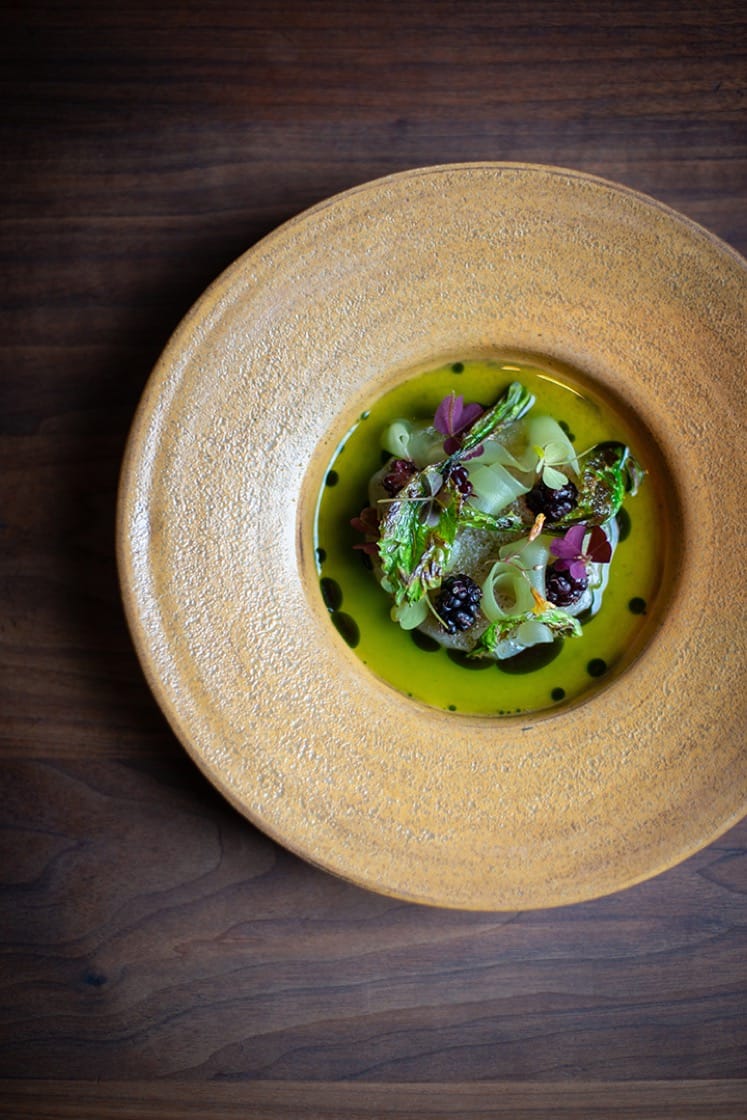Brett Cooper is the 37-year-old chef helming the kitchen at one-Michelin-starred Aster in San Francisco’s Mission District. Along with his team of chefs, Cooper delivers some of the most creative takes on Bay Area produce to diners five nights a week, and paired with a wine menu led by Kim Stone.
While establishing Aster’s foothold as a trendsetting restaurant in the competitive neighborhood, Cooper still manages to make the sourdough bread himself, which he sells to diners when there’s extra. Bread making is a ritual reinforced by one of Cooper’s prior positions as chef at Outerlands in Outer Sunset, where he worked from 2011 until 2014 (during which the rustic, bread-focused neighborhood restaurant rose to a become citywide destination).
Cooper also insists on making Aster’s butter in-house as well, using dairy from a single, biodynamically-raised cow living at the Summerfield Waldorf School and Farm in Santa Clara. “The school sends us small batches of the best cream I’ve ever tasted,” Cooper says, crediting this good fortune to Tim Page of FEED Sonoma, an organization that connects small farms to restaurants like Cooper’s across the Bay Area.

This summer, Aster expanded its tasting menu from four to seven courses, a decision made in part by popular demand, as many guests were ordering off the four-course tasting menu as dishes caught their eye.
Here, we ask Cooper about his experience with the coveted red guide as Aster has been recognized with one star by our inspectors for three years consecutively.
What was your first encounter with the MICHELIN Guide?
I moved to San Francisco in 2002. Before that, I lived in Colorado. There wasn’t a lot of talk about Michelin there as a teenager. As I was gearing up to move out here, I started to read about chefs like Thomas Keller and places like Rubicon and got a glimpse into this whole other world.
When I moved out here and was working at Rubicon, I remember being there when Stuart [Brioza] got his star. He’s a really humble guy, and we were all really young, working away. He was out of town and I was in the restaurant working really early in the morning, and he called to tell me. He was so excited, and then I was excited, and that’s when I felt I really encountered Michelin.

What were your thoughts when Aster received its first star?
At the time, we had only been open five or six months. We didn’t know if we’re going to get included or not. Our pastry chef Sean [Ehland], a friend of mine, who moved here from Charleston [where he was working at McCrady’s], was sort of giddy with me. We had a chef staging from Bogotá, Colombia, and all day he was walking around saying, “You guys are going to get a call.”
I was down in the basement, where we don’t have very good reception, and when I got upstairs I saw I had three missed calls from an unknown number. I couldn’t believe I missed it. We finally got the call, and that was very exciting.
How did you celebrate?
We had a big toast going into service, and we congratulated and thanked our staff. During service, our regular guests kept stopping by and bringing us bottles of Champagne or something [else]. During service, chefs I worked with at Rubicon showed up and sprayed me with Champagne.
Did receiving a star change the direction of your restaurant?
We agreed we had this obligation now to our guests to live up to this accolade that we’d been given. We’ve always really tried to stay really humble and if awards came our way, it was a honor to be included and recognized, but not something that changed us. We stay humble and keep our heads down.
What advice do you have for young chefs aiming for Michelin stars?
Satisfy your guests. Stay humble and believe in the work that you’re doing. It’s easy to get distracted these days. Stay true to what you believe, focus on your work in the kitchen and treat people well.
Photos courtesy of Aster.















